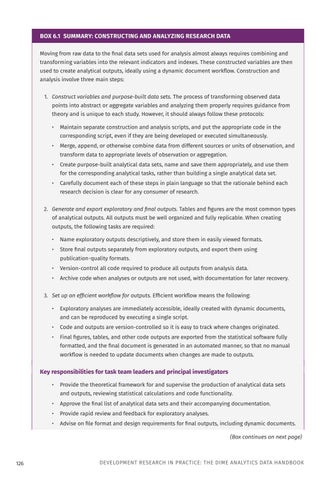BOX 6.1 SUMMARY: CONSTRUCTING AND ANALYZING RESEARCH DATA Moving from raw data to the final data sets used for analysis almost always requires combining and transforming variables into the relevant indicators and indexes. These constructed variables are then used to create analytical outputs, ideally using a dynamic document workflow. Construction and analysis involve three main steps: 1. Construct variables and purpose-built data sets. The process of transforming observed data points into abstract or aggregate variables and analyzing them properly requires guidance from theory and is unique to each study. However, it should always follow these protocols: • Maintain separate construction and analysis scripts, and put the appropriate code in the corresponding script, even if they are being developed or executed simultaneously. • Merge, append, or otherwise combine data from different sources or units of observation, and transform data to appropriate levels of observation or aggregation. • Create purpose-built analytical data sets, name and save them appropriately, and use them for the corresponding analytical tasks, rather than building a single analytical data set. • Carefully document each of these steps in plain language so that the rationale behind each research decision is clear for any consumer of research. 2. Generate and export exploratory and final outputs. Tables and figures are the most common types of analytical outputs. All outputs must be well organized and fully replicable. When creating outputs, the following tasks are required: • Name exploratory outputs descriptively, and store them in easily viewed formats. • Store final outputs separately from exploratory outputs, and export them using publication-quality formats. • Version-control all code required to produce all outputs from analysis data. • Archive code when analyses or outputs are not used, with documentation for later recovery. 3. Set up an efficient workflow for outputs. Efficient workflow means the following: • Exploratory analyses are immediately accessible, ideally created with dynamic documents, and can be reproduced by executing a single script. • Code and outputs are version-controlled so it is easy to track where changes originated. • Final figures, tables, and other code outputs are exported from the statistical software fully formatted, and the final document is generated in an automated manner, so that no manual workflow is needed to update documents when changes are made to outputs.
Key responsibilities for task team leaders and principal investigators • Provide the theoretical framework for and supervise the production of analytical data sets and outputs, reviewing statistical calculations and code functionality. • Approve the final list of analytical data sets and their accompanying documentation. • Provide rapid review and feedback for exploratory analyses. • Advise on file format and design requirements for final outputs, including dynamic documents. (Box continues on next page)
126
DEVELOPMENT RESEARCH IN PRACTICE: THE DIME ANALYTICS DATA HANDBOOK





